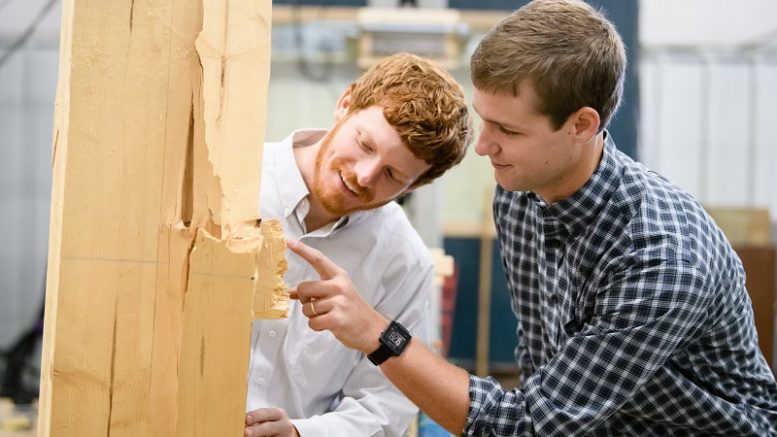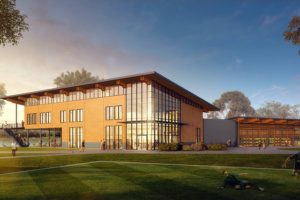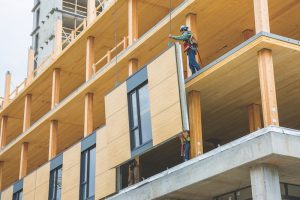 Michael Stoner was sitting in the Clemson University building where he helped conduct some of the nation’s first research into mass timber, when Graham Montgomery walked in and set a paper bag containing a sausage biscuit onto the table.
Michael Stoner was sitting in the Clemson University building where he helped conduct some of the nation’s first research into mass timber, when Graham Montgomery walked in and set a paper bag containing a sausage biscuit onto the table.
The gesture was a throwback to old times, when Stoner was an undergraduate, Montgomery was a master’s student and mass timber was new to the United States.
Montgomery used to give biscuits as a thank-you to the five undergraduates who turned out at 8 a.m. every Friday to help with the mass timber research he was doing for his thesis.
In the long run, Stoner and the other students received something more than a weekly breakfast sandwich. They learned how their undergraduate civil engineering courses could be applied outside the classroom
The focus of the student research, mass timber, is touted as an environmentally sustainable alternative to steel and concrete that is catching on fast across the country, from an office tower in Milwaukee to an airport terminal in Portland, Oregon.
And now it has come to Clemson University, too.
The new Snow Family Outdoor Fitness and Wellness Center is built with a type of mass timber, cross-laminated timber. It’s among the first ever projects involving cross-laminated timber made from southern yellow pine, Montgomery and Stoner said.
When the students started their research in 2013, mass timber had been used in Europe for years but was just starting to catch on in the United States.
Stoner said that at the time it seemed like a cool but far-fetched idea to have a mass-timber building on campus.
“In my time here, we’ve gone from pressing the first southern yellow pine pieces to having a completed building on campus,” Stoner said. “That’s huge progress.”
Montgomery said he was able to get in on the ground floor of a growing industry while still a Clemson student.
“I got to go to the first conference in the U.S. on this when it was just a baby– and basically when I was just a baby in the industry,” Montgomery said. “I’ve been able to grow alongside the whole way. A lot of people don’t know about this, and I did some of the first research on it.”
The work helped prepare Montgomery and Stoner for the next chapters in their lives.
Montgomery is now mass timber technical director for Swinerton, a general contractor construction company with an office in Greenville. He oversees Stoner, who works part-time at Swinerton, while pursuing his Ph.D. in civil engineering at Clemson.
Mass timber is made of wood panels usually held together by glue, nails or dowels. Advocates said it allows for fast construction and requires fewer fossil fuels than other building materials, while maintaining fire protection and seismic resistance standards.
Mass timber also helps increase the value of locally cut timber, which often comes from private land, Montgomery said. Further, wood can be grown, making it the only renewable building material, he said.
For his thesis, Montgomery investigated how to lengthen spans of mass timber. The longer the span, the thicker the pieces of mass timber had to be, he said.
At 22-25 feet, the mass timber would have to become about a foot deep, too thick to be efficient, Montgomery said.
Montgomery began to look into how three pieces could be connected to make a wooden version of an I-beam. He tested the idea with computer models and found that the connections between the pieces of wood were key.
Then it was time to do some testing with actual pieces of wood.
The student team started to gather every Friday in Lehotsky Hall, where they would cut lengths of timber into sections a little over four feet long. The pieces then had to be run through a large planar.
Students would mix glue, spread it on the boards, stick them together, put them in a press and apply the right amount of pressure. Their work had to be done quickly, and they kept time with a stopwatch.
They would let the pieces sit a few hours and then cut them into smaller pieces. Students then hauled their wood creations to the Wind Load Test Facility, where Clemson has machines that can test how much pressure the wood can take.
“A lot of those screws would pop, so the failure would be loud,” Stoner recalled. “Sometimes, we were putting a lot on there.”
“It was a range of 20,000 pounds to 120,000 pounds,” Montgomery added.
The research gatherings went on for more than a year.
Montgomery said the project showed him that “dedicated people are extremely valuable,” and Stoner said he had the chance to learn from Montgomery.
“It was never a dull, ‘let’s just get this done,’” Montgomery recalled. “We were always talking about something we were learning. We would sometimes talk about stuff that didn’t apply to wood and that I was learning in my master’s classes or in my internship.”
Stoner said the research showed him how his courses could apply outside the classroom.
“Physics wasn’t just physics anymore– it was a building,” he said. “It was all coming together, and right at that point is when I started doing this work. In classes, you absorb it and don’t get to talk about it. Graham gave me the outlet to talk about it.”
The research was offered through Creative Inquiry, a Clemson undergraduate research program, and sponsored by the Clemson Wood Utilization + Design Institute, where Patricia A. Layton serves as director.
“This research is one way Clemson University supports the mass timber movement,” Layton said. “We are leading the way in making wood a first-choice building material, not only in South Carolina but across the country.”
Jesus M. de la Garza, chair of the Glenn Department of Civil Engineering, said the research serves as an example of how undergraduate research can enhance students’ educational experience.
“Research plays a key role in showing students how what they learn from books and professors applies outside the classroom,” he said. “It helps energize their education and keeps them engaged. Clemson offers many opportunities for undergraduates to participate in research, especially through the Creative Inquiry program. I encourage them to find projects that spark their interests.”
The number of students participating in Creative Inquiry reached 101 in the 2018-19 academic year, an increase of more than 26 percent over five years earlier, said Barbara J. Speziale, the director of Creative Inquiry.
Montgomery recently had the chance to attend a topping-off ceremony for the Snow Family Outdoor Fitness and Wellness Center. He was offered the opportunity to sign the inside of an elevator shaft, and he wrote a thank-you to his master’s advisor, former Clemson professor Scott Schiff.
“I was very grateful to have this opportunity– and this is what it turned out to be,” Montgomery said.
Clemson University Contacts:
To arrange interviews, photo and video, call Paul Alongi at 864-350-7908.




Be the first to comment on "Clemson Connection; Civil engineers see ‘huge progress’ in mass timber as new building opens at Clemson University"